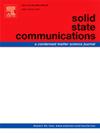Valley and spin filtering using multiple Magnetic barriers on a TMDC nanoribbon
IF 2.1
4区 物理与天体物理
Q3 PHYSICS, CONDENSED MATTER
引用次数: 0
Abstract
A quantum system is investigated as a valley and spin filter using the three-band tight-binding model (TBM) and Landauer–Büttiker formalism. In a transition-metal dichalcogenide (TMDC) zigzag nanoribbon (ZNR) with multiple magnetic barriers, the valley Zeeman effect causes broken valley degeneracy of the and valleys in each magnetic barrier (MB) region. The energy band shifts upward for the valley and downward for the valley, or vice versa, depending on the direction of the magnetic field. The influence of an MB on carriers moving from the source to the drain varies depending on the valley involved. Fano resonance in the valley and resonance tunneling in the valley make the main contributions to valley polarization. With intrinsic spin–orbit coupling (SOC) and the ordinary Zeeman effect, the spin degeneracy of the energy bands in both valleys is broken, leading to spin polarization. Both polarizations can be enhanced by increasing either the number of MBs or the strength of the external magnetic field. With the optimized parameters of this system, it is possible to obtain currents with selective spin and valley by manipulating the incident carrier energy. An experimental implementation of this system could enable control over the carriers’ spin and valley degrees of freedom in upcoming devices.
在TMDC纳米带上使用多个磁势垒的谷和自旋滤波
利用三波段紧密结合模型(TBM)和landauer - b ttiker形式化理论研究了一个量子系统作为谷和自旋滤波器。在具有多个磁势垒的过渡金属二硫族化合物(TMDC)之字形纳米带(ZNR)中,谷塞曼效应导致每个磁势垒(MB)区域的K和K′谷的破谷简并。K谷的能带向上移动,K谷的能带向下移动,反之亦然,这取决于磁场的方向。MB对载流子从源极移动到漏极的影响取决于所涉及的谷。K谷中的法诺共振和K谷中的共振隧穿是谷极化的主要原因。在本征自旋轨道耦合(SOC)和普通塞曼效应的作用下,两个谷中能带的自旋简并被破坏,导致自旋极化。这两种极化都可以通过增加mb的数量或增加外部磁场的强度来增强。在优化后的系统参数下,可以通过控制入射载流子能量来获得具有选择性自旋和谷的电流。该系统的实验实现可以在即将推出的设备中控制载波的自旋和谷自由度。
本文章由计算机程序翻译,如有差异,请以英文原文为准。
求助全文
约1分钟内获得全文
求助全文
来源期刊

Solid State Communications
物理-物理:凝聚态物理
CiteScore
3.40
自引率
4.80%
发文量
287
审稿时长
51 days
期刊介绍:
Solid State Communications is an international medium for the publication of short communications and original research articles on significant developments in condensed matter science, giving scientists immediate access to important, recently completed work. The journal publishes original experimental and theoretical research on the physical and chemical properties of solids and other condensed systems and also on their preparation. The submission of manuscripts reporting research on the basic physics of materials science and devices, as well as of state-of-the-art microstructures and nanostructures, is encouraged.
A coherent quantitative treatment emphasizing new physics is expected rather than a simple accumulation of experimental data. Consistent with these aims, the short communications should be kept concise and short, usually not longer than six printed pages. The number of figures and tables should also be kept to a minimum. Solid State Communications now also welcomes original research articles without length restrictions.
The Fast-Track section of Solid State Communications is the venue for very rapid publication of short communications on significant developments in condensed matter science. The goal is to offer the broad condensed matter community quick and immediate access to publish recently completed papers in research areas that are rapidly evolving and in which there are developments with great potential impact.
 求助内容:
求助内容: 应助结果提醒方式:
应助结果提醒方式:


